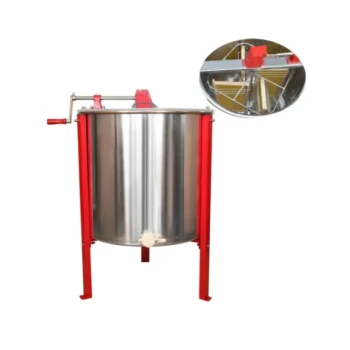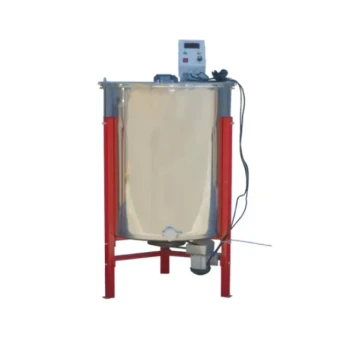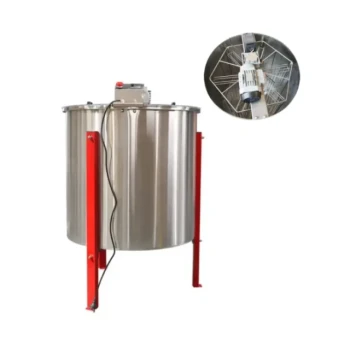The most common way to extract honey is by removing the wax caps from the honeycomb, placing the frames in a machine called a honey extractor, and using centrifugal force to spin the honey out. This method is highly efficient and preserves the delicate honeycomb, which can then be returned to the hive for the bees to refill. However, simpler, lower-cost methods like crushing or pressing the comb also exist.
The core decision in honey extraction is choosing between methods that preserve the honeycomb for the bees to reuse (centrifugal extraction) and methods that destroy it (crush and strain). This choice directly impacts your equipment cost, efficiency, and the bees' subsequent workload.
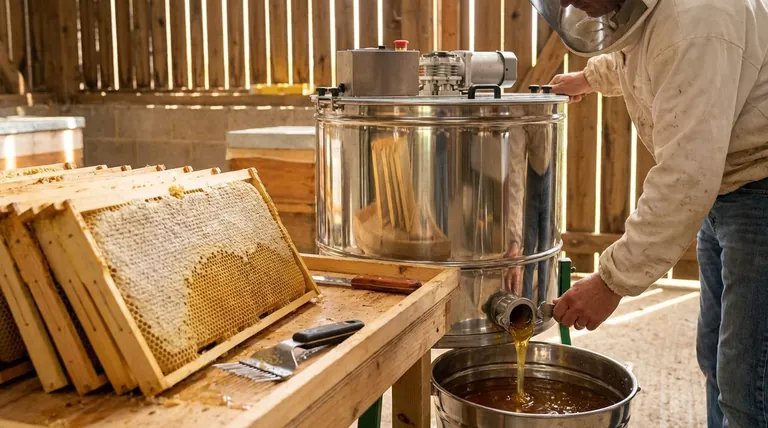
Preparing the Frames for Extraction
Before you can extract the honey, you must prepare the honeycomb frames. This involves two critical, non-negotiable steps: removing the bees and uncapping the honey cells.
Step 1: Removing the Bees
Your first task is to separate the bees from the honey you intend to harvest. This must be done gently to minimize stress on the colony.
One common technique is to use a bee brush to sweep the bees off each frame. Alternatively, a device called a bee escape board can be placed between the honey chambers and the main hive body, creating a one-way exit for the bees to leave the honey frames over 24-48 hours.
Step 2: Uncapping the Honeycomb
Bees seal each cell of finished honey with a protective layer of beeswax, known as "cappings." This wax must be removed to allow the honey to flow out.
This process, called uncapping, is typically done with a specialized hot knife or an uncapping fork. The goal is to slice off only the top layer of wax, exposing the liquid honey within the cells.
The Three Core Extraction Methods
Once the frames are free of bees and uncapped, you can choose your extraction method based on your scale, budget, and philosophy.
Centrifugal Extraction: The Professional Standard
This is the most efficient and widely used method, especially for beekeepers who plan to continue the hobby.
The uncapped frames are placed inside a honey extractor, which is a large drum that spins the frames at high speed. Centrifugal force flings the liquid honey out of the cells and onto the inner wall of the drum, where it drips down to a collection spout at the bottom.
Crush and Strain: The Low-Tech Approach
This is the simplest and oldest method of honey extraction, requiring no specialized machinery.
The entire honeycomb, wax and all, is cut from the frame and crushed in a bucket. This mixture is then poured through a series of strainers or cheesecloth to separate the liquid honey from the wax debris.
The Pressing Method: A Controlled Alternative
A honey press offers a middle ground between the industrial efficiency of an extractor and the simplicity of crushing.
In this method, pieces of honeycomb are placed into a press. A plate is then screwed down, applying immense pressure that squeezes the honey out of the comb, leaving behind a compressed cake of beeswax.
Understanding the Trade-offs
Choosing a method is not just about getting honey; it's about managing your resources and your hive's long-term health.
Equipment Cost vs. Long-Term Yield
A centrifugal extractor is a significant upfront investment. However, because it preserves the comb, the bees do not have to expend energy rebuilding it. They can immediately begin refilling it, which often leads to a higher honey yield in the long run. The crush-and-strain method is nearly free to start but forces the bees to rebuild comb from scratch every time.
Comb Preservation is Bee-Friendly
Building wax comb is an energy-intensive process for bees. It is estimated they consume several pounds of honey to produce just one pound of wax. By returning empty, intact combs to the hive, you are saving the colony a tremendous amount of work and resources.
Labor and Cleanliness
Centrifugal extraction is clean, fast, and highly efficient for processing multiple frames. The crush and press methods are significantly more labor-intensive and messy, requiring extensive straining to produce clean honey.
Making the Right Choice for Your Goal
Your goals as a beekeeper will determine the best extraction method for your situation.
- If your primary focus is hive health and maximizing honey yield over time: Invest in a centrifugal extractor to preserve the bees' honeycomb.
- If your primary focus is a low-cost start with one or two hives: The crush and strain method is the most accessible way to begin.
- If your primary focus is a small-scale, non-electric, and controlled process: A honey press provides a clean extraction but at the cost of destroying the comb.
Ultimately, extracting honey is the rewarding final step that connects your efforts in the apiary to the product in the jar.
Summary Table:
| Method | Key Equipment | Preserves Comb? | Best For |
|---|---|---|---|
| Centrifugal Extraction | Honey Extractor | Yes | Commercial apiaries, serious hobbyists |
| Crush and Strain | Bucket, Strainers | No | Low-cost start, small-scale beekeepers |
| Pressing | Honey Press | No | Small-scale, controlled, non-electric process |
Ready to scale your honey harvesting operation?
As a trusted supplier for commercial apiaries and beekeeping equipment distributors, HONESTBEE provides the durable, high-capacity equipment you need for efficient, bee-friendly honey extraction. Our wholesale-focused operations ensure you get the best value on extractors, uncapping tools, and more.
Contact our experts today to discuss how we can support your business and maximize your honey yield.
Visual Guide
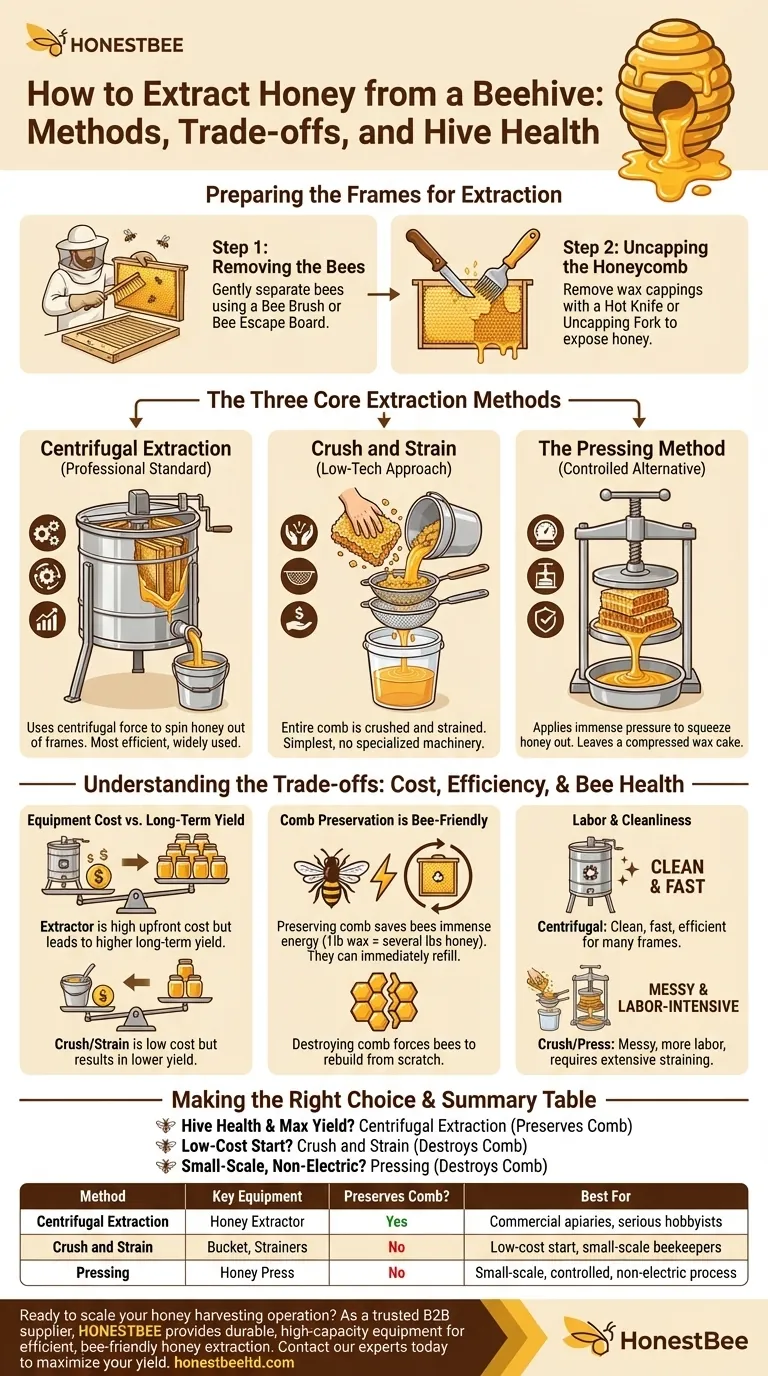
Related Products
- Electric 8 Frame Honey Spinner Extractor Equipment for Beekeeping
- HONESTBEE 4 Frame Manual Self Reversing Honey Extractor for Beekeeping
- 2 Frame Stainless Steel Manual Honey Spinner Extractor for Beekeeping
- Stainless Steel Manual 8 Frame Radial Honey Extractor Machine for Beehives
- HONESTBEE 3-Frame Manual Acrylic Honey Extractor
People Also Ask
- Why is cleaning a honey extractor important in beekeeping? Protect Your Honey Quality & Equipment
- What should be considered when harvesting honey from multiple hives? Scale Your Harvest Efficiently
- What equipment is needed for extracting honey? A Complete Guide for Every Beekeeper
- What machines are needed in beekeeping besides basic tools? Scale Your Honey Harvest Efficiently
- What are the benefits of using a honey extractor? Maximize Harvest & Save Bee Energy

